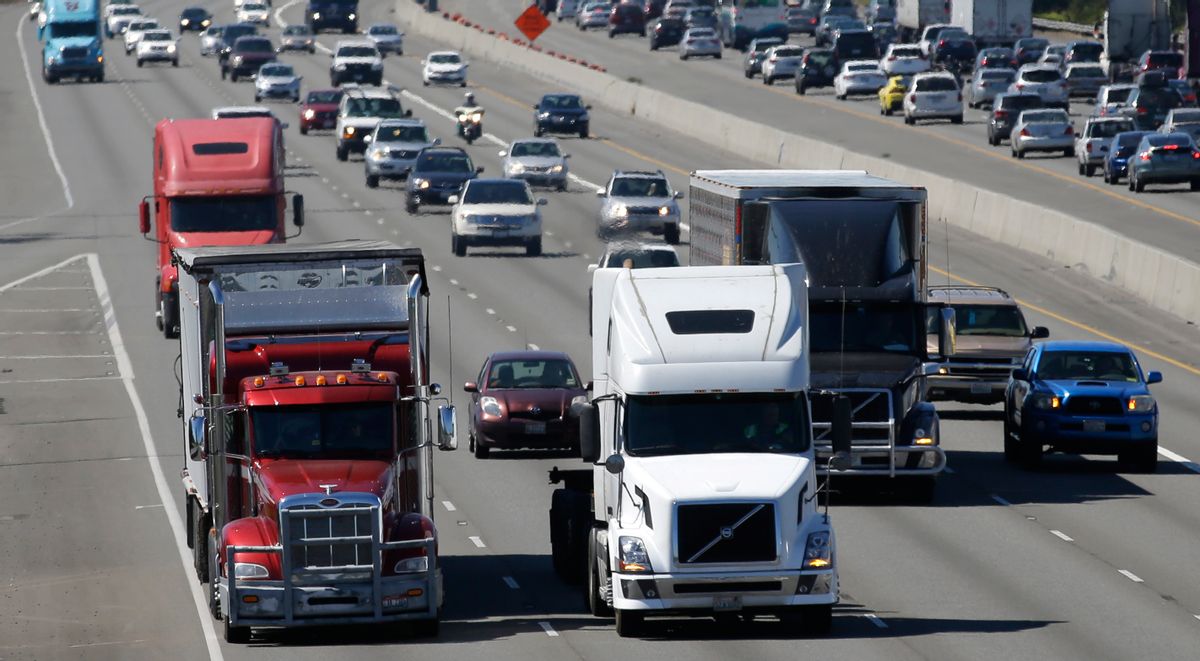It is easy to be distracted by the autonomous car industry, as shiny, self-driving vehicles from Waymo, Tesla, GM and others navigate without (much) human guidance.
However as glitzy as this may be, autonomy is also shaking up the trucking industry in an equally profound way. They might not capture as many headlines, or find themselves the stars of the world's most glamorous motor shows. But they are being worked on by at least half a dozen companies right now — some are decades-old automakers, others are brand new startups.
Here, GearBrain looks at six autonomous truck companies we think you should know.
Embark
The aim of San Francisco-based Embark is to automate the freeway part of a truck's journey. Founded in 2016, Embark lets the system take over, with the driver taking over when the truck exits the freeway, to navigate the more complex roads of towns and cities themselves.
The approach is designed so truck drivers can complete more journeys per day, as they're spending less time doing the actual driving. The company is currently operating test vehicles (with humans monitoring from behind the wheel) on the I-10 freeway between El Paso, Texas and Palm Springs, California.
Embark has already used its technology to drive a truck across the U.S., through adverse weather conditions like rain and fog, navigating highway transfers without human assistance. Embark's employees previously worked at companies like Audi and Apple, and the startup has raised an estimated $17.2 million, according to data by Crunchbase, valuing it at $75 million.
Daimler / Mercedes
An automotive veteran and parent of Mercedes-Benz, Daimler has been in the autonomous truck race for longer than most others, first demonstrating a self-driving vehicle back in 2014. Called the Mercedes-Benz Future Truck 2025, the vehicle uses a system called Highway Pilot to navigate highways without human assistance.
So far, Mercedes has concentrated on platooning, where trucks drive themselves closely behind one another, reducing air resistance and lowering their fuel usage by a claimed 10 percent. Each vehicle still has a driver for safety and for taking over when exiting the freeway.
Uber / Otto
Uber acquired autonomous truck startup Otto in the summer of 2016 for $650 million, seven months after it was founded. Now a part of Uber's Advanced Technologies Group, the trucks can drive themselves on the highway — but hands itself over to a human driver to navigate the smaller and more complex roads until they reach their destination.
In October 2016, an Otto truck hauled almost 52,000 can of Budweiser 120 miles along the Interstate 25 through Colorado. The driver sat in the back of the cab, while the truck navigated the highway itself — albeit with a police escort.
As of March 2018, Uber said its autonomous trucks had driven a collective two million miles, and that they had begun regularly transporting freight in Arizona. However, all of Uber's autonomous trials in the U.S. and Canada were put on hold after one of the company's autonomous test cars struck and killed a pedestrian in Tempe, Arizona. It is not known when testing on public roads — of its cars or trucks — will restart.
Waymo
Better known as Google's self-driving car division, Waymo announced in March 2018 it has plans to automate trucks too. That month, the company launched a pilot in Atlanta where Waymo-branded trucks carried freight bound for Google's data centers.
Although Waymo tested its truck-driving system for a year in California and Arizona ahead of the pilot, it still has "highly trained" safety drivers behind the wheel to monitor the technology and take over control if required.
Waymo said in March: "Our software is leaning to drive big rigs in much the same way a human driver would after years of driving passenger cars. The principles are the same, but things like braking, turning, and blind spots are different with a fully-loaded truck and trailer."
Despite fears that autonomous trucks will cause widespread unemployment in the driving community, Waymo says: "Trucking is a vital part of the American economy, and we believe self-driving technology has the potential to make this sector safer and even stronger."
Volvo
In 2016, Volvo demonstrated how its autonomous trucks platoon to improve both safety and efficiency.
It may not have been the most exciting demo, but when it comes to 70,000-pound trucks barreling down the highway under computer control, boring is exactly what you want.
The demonstration showed how the lead truck controls the accelerator and brakes of the two following trucks, meaning they all speed up and slow down together, thus removing the delays caused by driver reaction time.
Platooning like this also helps remove unnecessary braking and accelerating, and following each other closely lowers wind resistance, which in turn lowers fuel use. Drivers still all look after their own steering, but Volvo says this could also be automated in the future.
Volvo, which has partnered with FedEx, claims that if the computer-controlled trucks follow each other just one second apart, fuel economy can be improved by 10 percent, leading to significant savings for haulage companies who employ such a system.
Tesla
Tesla unveiled its first truck in November 2017 and plans to start delivering the electric vehicles in 2019. Company boss Elon Musk said at the launch that the semis would get Tesla's Autopilot self-driving software as standard.
Like on Tesla cars, Autopilot for trucks will provide a semi-autonomous system where the vehicle's accelerator, brakes and steering are managed by the computer on highways with clear lane markings, but the driver must remain fully alert and with a hand on the wheel at all times.
On top of this, Musk said this version of Autopilot will have truck-specific features like an anti-jackknifing system. The eventual goal is to employ a platooning feature for Tesla trucks to autonomously follow each other and have only the lead truck controlled fully by a human driver.


Shares